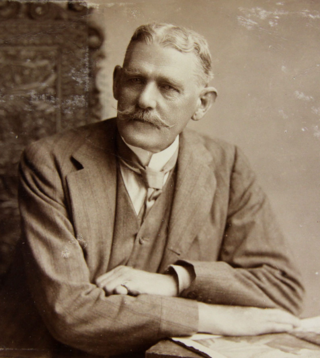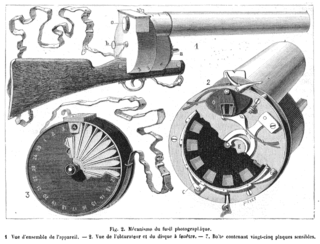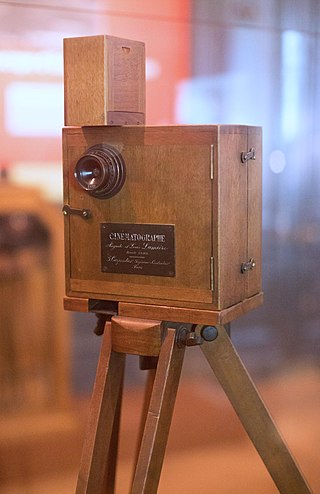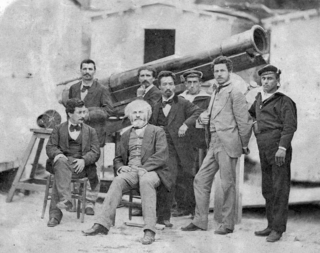Related Research Articles

Charles-Émile Reynaud was a French inventor, responsible for the praxinoscope and was responsible for the first projected animated films. His Pantomimes Lumineuses premiered on 28 October 1892 in Paris. His Théâtre Optique film system, patented in 1888, is also notable as the first known instance of film perforations being used. The performances predated Auguste and Louis Lumière's first paid public screening of the cinematographe on 26 December 1895, often seen as the birth of cinema.

Chronophotography is a photographic technique from the Victorian era which captures a number of phases of movements. The best known chronophotography works were mostly intended for the scientific study of locomotion, to discover practical information for animal handlers and/or as reference material for artists. Although many results were not intended to be exhibited as moving pictures, there is much overlap with the more or less simultaneous quest to register and exhibit photographic motion pictures.

Precursors of film are concepts and devices that have much in common with the later art and techniques of cinema.

Wordsworth Donisthorpe was an English barrister, individualist anarchist and inventor, pioneer of cinematography and chess enthusiast.
The decade of the 1890s in film involved some significant events.
The decade of the 1870s in film involved some significant events.
William Carr Crofts (1846–1894) was an English architect and entrepreneur who was a photographic pioneer.

The chronophotographic gun is one of the ancestors of the movie camera. It was invented in 1882 by Étienne-Jules Marey, a French scientist and chronophotographer. It could shoot 12 images per second and it was the first invention to capture moving images on the same chronomatographic plate using a metal shutter.

The Horse in Motion is a series of cabinet cards by Eadweard Muybridge, including six cards that each show a sequential series of six to twelve "automatic electro-photographs" depicting the movement of a horse. Muybridge shot the photographs in June 1878. An additional card reprinted the single image of the horse "Occident" trotting at high speed, which had previously been published by Muybridge in 1877.

The history of film technology traces the development of techniques for the recording, construction and presentation of motion pictures. When the film medium came about in the 19th century, there already was a centuries old tradition of screening moving images through shadow play and the magic lantern that were very popular with audiences in many parts of the world. Especially the magic lantern influenced much of the projection technology, exhibition practices and cultural implementation of film. Between 1825 and 1840, the relevant technologies of stroboscopic animation, photography and stereoscopy were introduced. For much of the rest of the century, many engineers and inventors tried to combine all these new technologies and the much older technique of projection to create a complete illusion or a complete documentation of reality. Colour photography was usually included in these ambitions and the introduction of the phonograph in 1877 seemed to promise the addition of synchronized sound recordings. Between 1887 and 1894, the first successful short cinematographic presentations were established. The biggest popular breakthrough of the technology came in 1895 with the first projected movies that lasted longer than 10 seconds. During the first years after this breakthrough, most motion pictures lasted about 50 seconds, lacked synchronized sound and natural colour, and were mainly exhibited as novelty attractions. In the first decades of the 20th century, movies grew much longer and the medium quickly developed into one of the most important tools of communication and entertainment. The breakthrough of synchronized sound occurred at the end of the 1920s and that of full color motion picture film in the 1930s. By the start of the 21st century, physical film stock was being replaced with digital film technologies at both ends of the production chain by digital image sensors and projectors.

The Janssen revolver was invented by the French astronomer Pierre Jules César Janssen in 1874. It was the instrument that originated chronophotography, a branch of photography based on capturing movement from a sequence of images. To create the apparatus Pierre Janssen was inspired by the revolving cylinder of Samuel Colt's revolver.
Events in 1888 in animation.
Events in 1882 in animation.
Events in 1878 in animation.
Events in 1877 in animation.
Events in 1875 in animation.
Events in 1873 in animation.
Events in 1862 in animation.
Events in 1861 in animation.
References
- ↑ Herbert, Stephen; Coe, Brian (2000). "Who's Who of Victorian Cinema" . Retrieved 2009-05-10.
- ↑ Herbert, Stephen (1998). Industry, Liberty, and a Vision: Wordsworth Donisthorpe's Kinesigraph. The Projection Box. ISBN 978-0-9523941-3-6.
- ↑ "Cinema Studies". 1960.
- ↑ Herbert, S. (1998). Industry, Liberty, and a Vision: Wordsworth Donisthorpe's Kinesigraph. London: The Projection Box. ISBN 0-9523941-3-8.
- ↑ Burns, Paul T. "The History of The Discovery of Cinematography – 1885 – 1889" . Retrieved 2009-05-10. and "Ten Remaining Frames of Donisthorpe's 1890 'Trafalgar Square' Footage Come To Life" (GIF). Retrieved 2009-05-10.
- ↑ Bendazzi 1994, p. 4.
- ↑ Myrent 1989, p. 192-193.
- ↑ "Le Praxinoscope". emilereynaud.fr (in French). Retrieved 2019-07-25.
- ↑ "Revolver fotográfico | IDIS". proyectoidis.org. Retrieved 2018-11-30.
- ↑ Herbert, Stephen (1996). Who's Who of Victorian Cinema. British Film Institute.
- ↑ "Étienne Jules Marey" (PDF). Retrieved 28 June 2024.
- ↑ "Rifle fotográfico". 9 September 2008.
- ↑ Day Lance McNeil Ian (2002). Biographical Dictionary of the History of Technology. Routledge. p. 631. ISBN 1-134-65020-5.
- ↑ Hurter, Ferdinand & Driffield, Vero Charles (1890) Photochemical Investigations and a New Method of Determination of the Sensitiveness of Photographic Plates, J. Soc. Chem. Ind. May 31, 1890.
- ↑ Mees, C. E. Kenneth (May 1954). "L. A. Jones and his Work on Photographic Sensitometry" (PDF). Image, Journal of Photography of George Eastman House. III (5). Rochester, N.Y.: International Museum of Photography at George Eastman House Inc.: 34–36. Archived from the original (PDF) on 20 July 2014. Retrieved 15 July 2014.
- ↑ Adler, Kraig (1989). Contributions to the History of Herpetology. Society for the Study of Amphibians and Reptiles (SSAR).
- ↑ "BFI Screenonline: Dyer, Anson (1876-1962) Biography". www.screenonline.org.uk. Retrieved May 27, 2020.
- ↑ Pingitore, Silvia (2022-04-16). "La Rosa di Bagdad vs Cinderella, cartoon mystery & similarities: was Walt Disney inspired by an Italian movie you never heard of?". the-shortlisted.co.uk. Retrieved 2022-04-18.
- ↑ Osamu Tezuka, Tezuka Osamu Manga no Ougi (Secrets of Osamu Tezuka manga), pp. 16-27, ISBN 4-06-175991-4
- ↑ Isao Shimizu, Manga Tanjō (Birth of manga), ISBN 4-642-05475-8
- ↑ Isao Shimizu, Zusetsu Manga no Rekishi (Illustrated history of manga), ISBN 4-309-72611-9
- ↑ Bad Toelz, The History of the Bad Toelz Marionette Theatre, p. 1
- ↑ Dreyer, A (1907). Franz Pocci, der Dichter. Berlin: Künstler und Kinderfruend.
- ↑ Lucas, A (1929). Franz Pocci und das Kinderbuch. Künstler und Kinderfruend.
- ↑ Jouvanceau, Pierre (2004). The Silhouette Film. Pagine di Chiavari. trans. Kitson. Genoa: Le Mani. ISBN 88-8012-299-1.
- ↑ H. L. Mallalieu (1986). The Dictionary of British Watercolour Artists up to 1920. Antique Collectors' Club. p. 34. ISBN 1-85149-025-6.
- ↑ Prince, Stephen (2010). "Through the Looking Glass: Philosophical Toys and Digital Visual Effects" (PDF). Projections. 4 (2). Berghahn Journals. doi:10.3167/proj.2010.040203. ISSN 1934-9688.